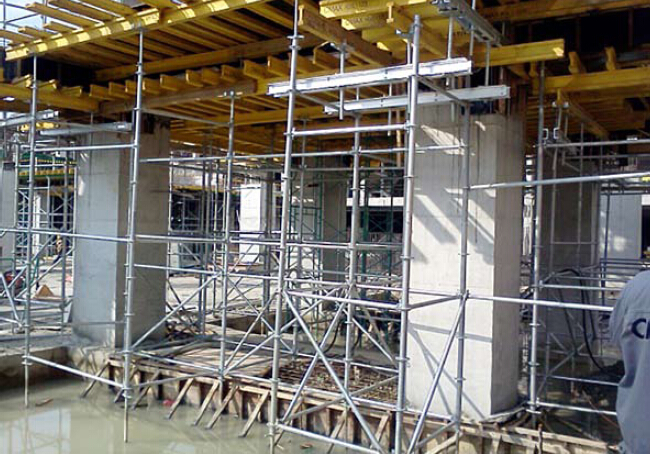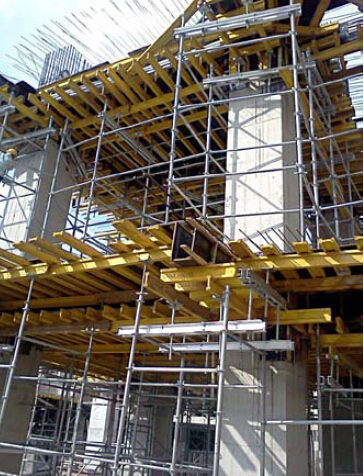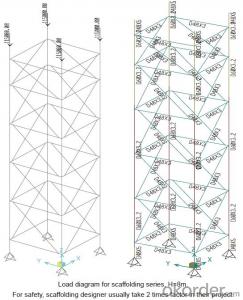Ringlock Scaffolding accessories for formwork and scaffolding system
- Loading Port:
- Tianjin
- Payment Terms:
- TT OR LC
- Min Order Qty:
- 50 m²
- Supply Capability:
- 1000 m²/month
OKorder Service Pledge
Quality Product, Order Online Tracking, Timely Delivery
OKorder Financial Service
Credit Rating, Credit Services, Credit Purchasing
You Might Also Like
Ring-lock Scaffolding
A support system for construction, ownsadvantages of both cup-lock scaffolding andshoring tower.
It is in the development direction of new typescaffolding.
It is widely used in buildings, bridges, tunnels etc..
Characteristics:
◆ Easy to storage and transportation
◆ High degree of standardization
◆ Easy and quick erection
◆ Excellent stability and bearing capacity


- Q:Can steel formwork be used for architectural concrete beams?
- Yes, steel formwork can be used for architectural concrete beams. Steel formwork offers several advantages over traditional wooden formwork, such as increased durability and reusability. Steel formwork is stronger and more rigid, allowing for precise and accurate construction of architectural concrete beams. It also provides a smooth and consistent surface finish, which is important for achieving the desired aesthetic appearance of the beams. Additionally, steel formwork can be easily assembled, disassembled, and transported, making it a practical choice for architectural concrete beam construction.
- Q:Can steel formwork be used in coastal or marine construction projects?
- Yes, steel formwork can be used in coastal or marine construction projects. Steel formwork is known for its durability and strength, making it a suitable choice for projects in harsh environments such as coastal or marine areas. Its resistance to corrosion allows it to withstand the corrosive effects of saltwater and other coastal elements. Additionally, steel formwork can be easily reused and recycled, making it a cost-effective and sustainable option for coastal or marine construction projects.
- Q:How does steel formwork compare to plywood formwork?
- Steel formwork and plywood formwork are commonly used materials in construction for creating molds or frameworks for concrete structures. Both materials have their pros and cons, but steel formwork generally has several advantages over plywood formwork. One of the main benefits of steel formwork is its durability and longevity. Steel is a strong material that can handle heavy loads and repeated use without losing its structural integrity. Unlike plywood, which can warp, expand, or deteriorate over time due to moisture, steel formwork can be used for multiple projects, making it a cost-effective choice in the long term. Another advantage of steel formwork is its precision and accuracy. Steel molds can be manufactured with great precision, ensuring that the final concrete structure meets all the required specifications. This is especially important for complex or intricate designs where accuracy is crucial. Plywood formwork may not provide the same level of precision due to its flexibility and susceptibility to warping. Steel formwork also offers improved safety features. Due to its rigidity and strength, steel molds provide a stable and secure working platform for construction workers. This reduces the risk of accidents and injuries during the concrete pouring and curing process. Plywood formwork, although commonly used, may have a higher risk of collapse or failure, especially in large-scale projects or areas with adverse weather conditions. Furthermore, steel formwork can be easily assembled and disassembled, allowing for efficient and quick construction processes. Steel molds are usually prefabricated and can be easily transported to the construction site, minimizing the need for on-site carpentry work. Plywood formwork, on the other hand, requires more time and effort to set up and dismantle, resulting in longer construction timelines and increased labor costs. However, it is important to note that steel formwork is generally more expensive upfront compared to plywood formwork. The initial cost of steel molds may be higher, but their long-term value and durability make them a worthwhile investment, especially for large construction projects or projects that require repetitive use of formwork. In conclusion, while both steel formwork and plywood formwork have their advantages, steel formwork offers several benefits in terms of durability, precision, safety, and efficiency. Despite the higher initial cost, steel formwork is a reliable and cost-effective choice for construction projects, particularly those that require high-quality finishes and complex designs.
- Q:How does steel formwork contribute to the overall sustainability of the construction industry?
- Steel formwork contributes to the overall sustainability of the construction industry in several ways. Firstly, steel formwork is highly durable and long-lasting. It can be reused multiple times, reducing the need for new formwork materials for each construction project. This significantly reduces the amount of waste generated during the construction process and minimizes the overall environmental impact of the industry. Additionally, steel formwork is a more sustainable alternative to traditional formwork materials such as timber. Timber formwork often requires cutting down trees, which contributes to deforestation and habitat destruction. By utilizing steel formwork, we can reduce our reliance on timber and help preserve forests. Steel formwork also offers greater structural stability and strength compared to other materials. This allows for more efficient construction processes and reduces the need for additional support structures. As a result, less material is wasted, energy is saved, and the overall construction time is shortened, making the process more sustainable. Furthermore, steel formwork is highly resistant to weather conditions, corrosion, and fire. This ensures the longevity of the buildings, reducing the need for frequent repairs or replacements. By using steel formwork, we can create structures that have a longer lifespan, resulting in reduced resource consumption and waste generation over time. Lastly, steel formwork is recyclable. At the end of its life cycle, steel formwork can be easily melted down and reused for other applications. This reduces the demand for new steel production, conserving natural resources and reducing energy consumption. In conclusion, steel formwork contributes to the overall sustainability of the construction industry by being durable, reusable, resistant to weather conditions, and recyclable. Its use helps minimize waste generation, deforestation, energy consumption, and resource depletion, making it an environmentally-friendly choice for construction projects.
- Q:How does steel formwork handle concrete consolidation and compaction?
- Steel formwork is highly suitable for concrete consolidation and compaction due to its durability and rigidity. The strong and rigid nature of steel formwork allows it to withstand the pressure exerted during concrete pouring and compaction. Additionally, steel formwork provides a smooth surface that facilitates proper consolidation and compaction of concrete, resulting in a high-quality finished product.
- Q:Can steel formwork be used for structures with high impact resistance requirements?
- Indeed, structures demanding high impact resistance can utilize steel formwork. Renowned for its robustness and durability, steel is ideal for enduring substantial impact loads. Its exceptional strength-to-weight ratio ensures remarkable protection against impact forces. Construction projects necessitating structures capable of withstanding heavy loads or potential impacts, like bridges, tunnels, and tall buildings, regularly employ steel formwork systems. Moreover, steel formwork permits effortless fabrication and assembly, enabling swift and efficient construction of structures with high impact resistance prerequisites.
- Q:Can steel formwork be used for precast concrete beams with complex geometries?
- Yes, steel formwork can be used for precast concrete beams with complex geometries. Steel formwork provides high strength and flexibility, allowing it to be easily shaped and adjusted to meet the specific geometrical requirements of the precast concrete beams. This makes it a suitable choice for creating complex and intricate shapes during the precast concrete beam manufacturing process.
- Q:What are the safety precautions when using steel formwork?
- When using steel formwork, there are several important safety precautions that should be followed to ensure the well-being of workers and the successful completion of the project. 1. Adequate training and awareness: All workers involved in using steel formwork should be properly trained on its safe handling and usage. They should be aware of the potential hazards and the correct procedures to follow. 2. Inspection and maintenance: Before using steel formwork, it is essential to inspect it thoroughly for any defects or damage. Any damaged or weakened parts should be repaired or replaced before use. Regular maintenance should be carried out to ensure the formwork remains in good condition. 3. Proper handling and storage: Steel formwork can be heavy and require multiple workers for handling. It is important to use appropriate lifting and handling equipment, such as cranes or forklifts, to avoid strain or injuries. When storing the formwork, it should be secured properly to prevent it from falling or causing accidents. 4. Fall protection: When working at heights with steel formwork, fall protection measures such as guardrails, safety nets, or personal fall arrest systems should be implemented. Workers should be provided with proper safety harnesses and trained on their usage. 5. Secure installation: Steel formwork should be securely installed to prevent collapse or movement during concrete pouring or other construction activities. It is crucial to follow the manufacturer's instructions and use appropriate bracing and support systems to ensure stability. 6. Adequate signage and barriers: Proper signage and barriers should be placed around the work area to warn others of potential hazards and restrict access to authorized personnel only. This helps in preventing accidents and keeping unauthorized individuals away from the construction site. 7. Personal protective equipment (PPE): All workers involved in using steel formwork should wear appropriate PPE, including hard hats, safety boots, gloves, and eye protection. This protects them from potential injuries caused by falling objects, sharp edges, or other hazards. 8. Regular communication and coordination: Effective communication and coordination among workers using steel formwork are crucial to maintain a safe working environment. Clear instructions, regular safety meetings, and the availability of emergency procedures ensure everyone is aware of their roles and responsibilities. By following these safety precautions, the risks associated with using steel formwork can be minimized, and a safe working environment can be maintained for all workers involved in the construction project.
- Q:What are the common challenges faced during steel formwork transportation?
- During steel formwork transportation, there are several common challenges that may arise. One of the main challenges is the weight and size of the steel formwork. Steel formwork can be heavy and bulky, making it difficult to transport and handle. This can require special equipment and vehicles to safely transport the formwork to the desired location. Another challenge is the potential for damage or deformation during transportation. Steel formwork needs to be transported in a way that prevents any bending, twisting, or scratching. Improper handling or inadequate securing of the formwork can lead to damage, which may affect its performance and durability. The logistics of transportation can also be a challenge. Coordinating the delivery of steel formwork to construction sites can be complex, especially when multiple projects are ongoing simultaneously. Ensuring that the formwork arrives on time and in the correct quantities requires careful planning and coordination. Furthermore, the terrain and road conditions can pose challenges during transportation. If the construction site is located in a remote or difficult-to-access area, the transportation of steel formwork can be more challenging. Poor road conditions, narrow access roads, or steep inclines may require additional measures to ensure safe transportation. Lastly, safety considerations are paramount during steel formwork transportation. The weight and size of the formwork can pose risks to the personnel involved in loading, unloading, and securing the formwork. It is essential to follow proper safety protocols and provide appropriate training to the workers involved to minimize the risk of accidents or injuries. Overall, the common challenges faced during steel formwork transportation include the weight and size of the formwork, potential for damage or deformation, logistics of delivery, terrain and road conditions, and safety considerations. By addressing these challenges effectively, the transportation process can be executed smoothly, ensuring the timely and safe delivery of steel formwork to construction sites.
- Q:How does steel formwork contribute to the overall fire safety of the building?
- The inherent properties and characteristics of steel formwork make it a valuable asset in enhancing the fire safety of a building. Firstly, steel formwork is renowned for its exceptional fire resistance. Its high melting point and resistance to ignition and burning make it a suitable choice for construction in fire-prone areas. In case of a fire, steel formwork remains structurally stable, serving as a vital barrier that contains the fire and prevents its spread to other sections of the building. This is particularly crucial in tall buildings where fire safety is of utmost importance. Furthermore, steel formwork is non-combustible, thereby minimizing the release of flammable gases and toxic fumes when exposed to fire. This is essential for the safety of occupants as smoke inhalation and toxic gases are leading causes of casualties in fire incidents. The utilization of steel formwork reduces the risk of smoke and toxic gases permeating throughout the building, allowing occupants more time to evacuate safely. Moreover, steel formwork is a durable and robust material capable of withstanding the impact of fire while retaining its structural integrity. This is vital in ensuring the stability of the building during a fire, preventing collapse, and reducing the likelihood of injuries or fatalities. Steel formwork can also resist the effects of high temperatures, such as thermal expansion, further contributing to the fire safety of the building. In conclusion, steel formwork plays a crucial role in enhancing the overall fire safety of a building. Its high fire resistance, non-combustible nature, and durability help contain fires, minimize the spread of smoke and toxic gases, and maintain the structural integrity of the building. By incorporating steel formwork into construction, the risk of fire-related incidents and their potential consequences can be significantly reduced, ensuring the safety of occupants and property.
1. Manufacturer Overview |
|
|---|---|
| Location | |
| Year Established | |
| Annual Output Value | |
| Main Markets | |
| Company Certifications | |
2. Manufacturer Certificates |
|
|---|---|
| a) Certification Name | |
| Range | |
| Reference | |
| Validity Period | |
3. Manufacturer Capability |
|
|---|---|
| a)Trade Capacity | |
| Nearest Port | |
| Export Percentage | |
| No.of Employees in Trade Department | |
| Language Spoken: | |
| b)Factory Information | |
| Factory Size: | |
| No. of Production Lines | |
| Contract Manufacturing | |
| Product Price Range | |
Send your message to us
Ringlock Scaffolding accessories for formwork and scaffolding system
- Loading Port:
- Tianjin
- Payment Terms:
- TT OR LC
- Min Order Qty:
- 50 m²
- Supply Capability:
- 1000 m²/month
OKorder Service Pledge
Quality Product, Order Online Tracking, Timely Delivery
OKorder Financial Service
Credit Rating, Credit Services, Credit Purchasing
Similar products
New products
Hot products
Related keywords





















